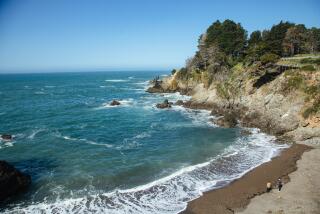3 Labs Sift DNA Evidence at Ground Zero
- Share via
The forensic analysts at Bode Technology Group spend most of their days helping solve rapes, homicides and other crimes in which offenders leave genetic footprints. Now they’re taking on the largest forensic investigation ever.
Small plastic vials have begun arriving at Bode’s laboratories in Springfield, Va. The vials contain genetic traces of lost lives: DNA extracted from those killed in the World Trade Center attack.
Bode employees are creating genetic profiles of the victims. “It’s always in the back of our minds that we’re doing this for the families,” said DNA analyst Mimi Chow, whose computer screen displayed genetic information from the first 38 DNA samples the lab has examined.
New York has enlisted three private laboratories to help identify the victims: Celera Genomics Corp., the Rockville, Md., company that mapped the human genome; Bode, one of the nation’s largest forensic labs; and Myriad Genetics Inc., of Salt Lake City.
The companies are working at reduced fees; executives and employees said they want to help bring peace of mind to people who lost relatives and friends in the attacks.
“We thought we had something to offer as a corporation to help the families,” said Craig Venter, Celera’s president and chief scientific officer. “There is a long history of how DNA sequencing can bring certainty to people’s lives.”
New York faces the daunting task of confirming the deaths of about 5,000 people still missing and presumed dead. “They want closure,” said Robert Shaler, head of forensic biology at the New York City medical examiner’s office. “They want to know what happened. They want their loved ones with them.”
Investigators have identified most of the victims at the Pentagon and Pennsylvania plane crashes, but the process is just getting started at the World Trade Center. Shaler’s lab has set aside one year for the project, but he said his staff is prepared to work as long as it takes to analyze every tissue sample.
Medical examiners traditionally identify victims of crime and disaster through fingerprints, dental records, wallets, tattoos or other telling body attributes. About 300 World Trade Center victims have been identified this way, but it’s impossible to identify most remains by such means. “Very few of the bodies are intact,” Shaler said.
So investigators are relying on DNA testing. Pioneered in the 1980s, the technique has been used to confirm the dead in several recent plane crashes, the Oklahoma City bombing and mass graves in Bosnia.
The idea is to identify victims by matching the DNA of recovered tissue samples with that of the presumed dead. Since the attacks, relatives have brought in victims’ personal items, such as razors, toothbrushes and chewing gum, that may contain their DNA. When such samples cannot be found, immediate relatives give their own DNA samples, which are genetically similar.
So far no victims have been identified by DNA analysis of the 5,800 tissue and bone samples that have been recovered, Shaler said. He eventually expects anywhere from 20,000 to 1 million samples to be retrieved. The medical examiner’s office extracts DNA from those samples and sends them to the laboratories of Myriad, Celera and Bode.
Scientists at Myriad are using a standard technique known as short tandem repeat, or STR. It involves reading 13 regions of a person’s genetic code, which is contained in the nucleus of every cell. By examining each region, analysts see how many times a particular sequence of chemical units is repeated.
The technique fails when the DNA is damaged by decay or intense heat. That’s when Celera comes in. The company will use its DNA sequencing facility, the world’s largest, to analyze mitochondria--tiny energy-producing organs outside a cell’s nucleus--which also contain DNA.
“The more samples degrade, the more important mitochondrial sequencing becomes,” Venter said. “Mitochondrial DNA is in higher concentration, lasts longer and can be extracted from bones.”
Celera rose to international fame when it raced the publicly funded Human Genome Project to sequence the 3.1 billion chemical units of the human genetic code. Because Celera can sequence up to 200,000 samples a day, Venter said the World Trade Center work won’t interfere with other projects. So far, more than 30 employees have been preparing for the project, but the company must wait to be certified as a forensic laboratory before it can begin.
Bode works with authorities in nine states, including New York, to identify criminals through DNA analysis. “As a hard-core forensic laboratory, we see what cruelty can come out of society,” said Thomas Bode, the firm’s founder and president. “We see the worst of the worst, unfortunately. But we also see the opportunity to bring justice.”
Bode Technology has been contracted by New York to examine up to 30,000 samples using the STR approach and 1,000 samples through mitochondrial DNA testing, but that number could grow, Bode said. The company plans to focus on particularly difficult samples, such as those extracted from bones and teeth. Bode also would analyze 5% of samples tested by Celera for quality control.
Mitchell Holland, Bode’s lab director, previously worked as lab chief of the Armed Forces DNA Identification Laboratory, the agency testing DNA samples at the Pentagon and Pennsylvania crash sites. He helped identify the remains of Russia’s last czarist family as well as Michael Blassie, the Vietnam soldier who was buried in the Tomb of the Unknowns at Arlington National Cemetery. “I’m confident that a large percentage of the individuals will be identified,” Holland said.
More to Read
Sign up for Essential California
The most important California stories and recommendations in your inbox every morning.
You may occasionally receive promotional content from the Los Angeles Times.










